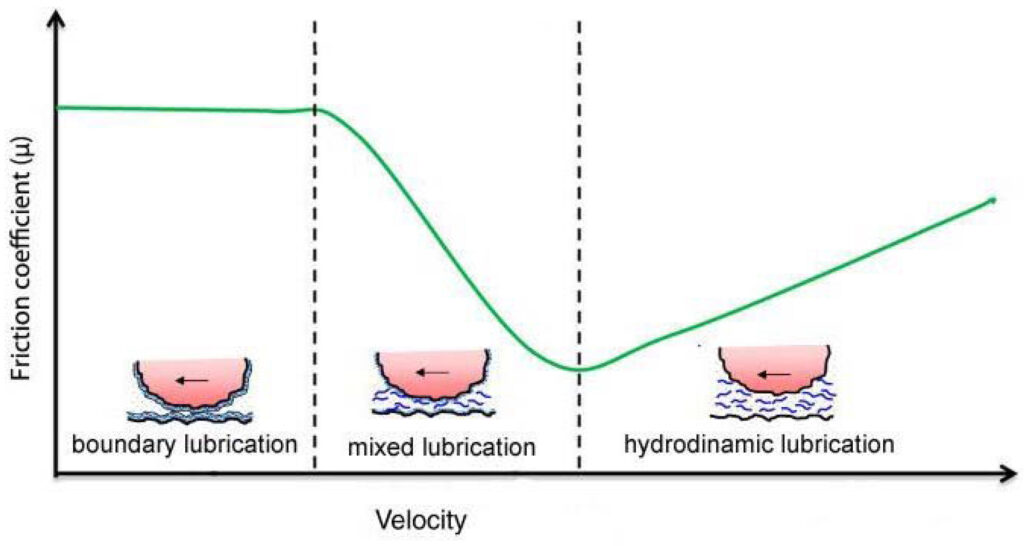I am currently working as a Postgraduate Researcher at the University of Leeds, where I am actively involved in research activities. Prior to this, I successfully completed my master's degree through the renowned Erasmus Mundus joint program, specializing in Tribology and Bachelor's degree in Mechanical Engineering from VTU in Belgaum, India. Further I handle the social media pages for Tribonet and I have my youtube channel Tribo Geek.
Mixed Lubrication Regime
Table of Contents
Background:
The lubrication regimes at the contact interface in any mechanical components are very important to be studied because it determines the efficiency of the components. The type of regime determines the tribological properties of the surface. There are various parameters that affect the lubrication such as the applied load, viscosity of the lubricant, pressure generated at the interface, velocity of the lubricant films, etc. The changes in these parameters give rise to different lubrication regimes which in turn affect the frictional behaviors of the surface. A mixed lubrication regime is one of the important lubrication regimes that have to be understood to improve efficiency in many applications.

Fig-1 Schematic Stribeck curve showing coefficient of kinetic friction (µ) as a function of sliding velocity in the three different lubrication regimens [1].
Definition:
The lubrication arises when the surface interfaces are in between the contact of the asperities on the surface and full film lubrication. This lubrication regime is called mixed film lubrication because it falls in between boundary lubrication and hydrodynamic lubrication. The proper understanding of this regime is the combined knowledge of the boundary and hydrodynamic lubrication regimes. So it is important to have a comprehensive knowledge of those lubrication regimes to study the mixed lubrication regime [2].

Fig-2 Schematic of mixed lubrication [3]
Friction in mixed lubrication:
The main purpose of the lubricant is to reduce the friction at the interface of the surfaces in contact. In the case of the mixed lubrication regime, the prediction and reduction the friction is a great challenge because the friction varies with the operating parameters such as temperature and speed. The friction prediction is difficult in this regime because it lies at the extreme boundaries of the boundary lubrication regime and enters the full film Lubrication or hydrodynamic lubrication regimes [2].

Fig-3 Friction force comparison between the experiment and simulation [4]
Mixed lubrication models:
Many studies have been done on mixed lubrication models for both conformal and nonconformal contacts. However, the deterministic and stochastic models are studied mostly.
- Stochastic model: In the case of the stochastic model the statistic parameters are used to study the effects of surface roughness on lubrication. But this model does not provide information on local pressure peak, local film thickness, and asperity deformation. The well-accepted analysis of this model is the combination of the average flow model and the asperity contact model [5]. On TriboNet, stochastic model based calculators are available for point and line contacts:
EHL Film Thickness Calculator (Central and Minimum): Elliptical (Point) Contact
- Deterministic model: In this model, the solvers can be categorized as separate and unified approaches. In the separate approach, different equations are solved for the solid and lubricated regions. However, in the case of the unified approach, the solutions are obtained from both solid and fluid pressures through Reynolds equations. Also, the information on the asperity pressures and the performance of the heavy-loaded lubricated contacts can be analyzed [6].

Fig-4 CFD investigation of the reynolds flow of the solid obstacles [7]
Research on Mixed lubrication regime:
There are various studies have been conducted on mixed lubrication such as modeling the lubrication regime, improving the efficiency of the mechanical components in this regime, etc. This section mainly focuses on this area of research to understand mixed lubrication.
- Mixed lubrication models: In the previous session we discussed the two approaches for modeling the mixed lubrication conditions, however, there are many more models that have been investigated by the researchers in studying mixed lubrication conditions. Various computer-based models are developed to study the effect of different parameters in mixed lubrication conditions. Wen-Zhong Wang et.al. studied the effect of various surface roughness parameters like skewness and Kurtosis. It was found that these parameters have a significant influence on contact area ratio, load ratio, maximum pressure, and temperature at the mixed lubrication regime [8]. The surface forces in mixed lubrication play an important role in achieving better lubrication since it affects the surface roughness parameters. Shuowen et.al., studied this effect using the unified mixed lubrication model and have identified that reducing the surface roughness improves the surface forces which helps in achieving super lubrication at low-speed conditions [9].
- Increasing efficiency using different surface modification techniques: various surface modification techniques were implemented by the researchers to increase the efficiency of the mechanical components. In a study on the tribological behavior of the steel sliding pairs Daniel Braun et.al., implemented laser surface texturing for improving the frictional properties in mixed lubrication conditions. They found that the major parameters influencing the friction reduction were the dimple diameter of the textured and the operating temperature, where the reduction in temperature improved the COF for lower dimple diameters [10].
On TriboNet, 2 EHL Film thickness calculators are available:
EHL Film Thickness Calculator (Central and Minimum): Line (Cylindircal) Contact
EHL Film Thickness Calculator (Central and Minimum): Elliptical (Point) Contact
Reference:
[2] Spikes, H.A., 1997. Mixed lubrication—an overview. Lubrication Science, 9(3), pp.221-253.
[3] Zhang, Y., Kovalev, A. and Meng, Y., 2018. Combined effect of boundary layer formation and surface smoothing on friction and wear rate of lubricated point contacts during normal running-in processes. Friction, 6(3), pp.274-288.


Be the first to comment